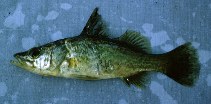Lates angustifrons Boulenger, 1906
Tanganyika lates
Adicionar o seu Fotografias e vídeos
Pictures | Imagem do GoogleLates angustifrons
Picture by de Vos, L.
Pictures | Imagem do GoogleLates angustifrons
Picture by de Vos, L.
Burundi country information
Common names:
Sangala
Occurrence: native
Salinity: freshwater
Abundance: | Ref:
Importance: | Ref:
Aquaculture: | Ref:
Regulations: | Ref:
Uses: live export: yes;
Comments: Present in Lake Tanganyika (Ref. 36901). Also Ref. 41590, 45485.
National Checklist:
Country Information: https://www.cia.gov/library/publications/resources/the-world-factbook/geos/by.html
National Fisheries Authority:
Occurrences: Occurrences Point map
Main Ref: Poll, M., 1953
National Database:
Occurrence: native
Salinity: freshwater
Abundance: | Ref:
Importance: | Ref:
Aquaculture: | Ref:
Regulations: | Ref:
Uses: live export: yes;
Comments: Present in Lake Tanganyika (Ref. 36901). Also Ref. 41590, 45485.
National Checklist:
Country Information: https://www.cia.gov/library/publications/resources/the-world-factbook/geos/by.html
National Fisheries Authority:
Occurrences: Occurrences Point map
Main Ref: Poll, M., 1953
National Database:
Common names from other countries
Classificação / Names Nomes comuns | Sinónimos | Catalog of Fishes(Género, Espécies) | ITIS | CoL | WoRMS | Cloffa
> Carangaria/misc (Various families in series Carangaria) > Latidae (Lates perches)
Etymology: Lates: Latin, lateo, latere = to be hidden.
More on author: Boulenger.
Etymology: Lates: Latin, lateo, latere = to be hidden.
More on author: Boulenger.
Environment: milieu / climate zone / depth range / distribution range Ecologia
; Água doce demersal; pH range: 7.5 - 8.2; dH range: 20 - 40. Tropical; 22°C - 28°C (Ref. 12468); 3°S - 9°S
Distribuição Países | Áreas FAO | Ecossistemas | Ocorrências | Point map | Introduções | Faunafri
Africa: widely distributed in Lake Tanganyika (Ref. 2216, 36901) and present in the Malagarazi River delta (Ref. 54847).
Length at first maturity / Tamanho / Peso / Idade
Maturity: Lm 56.5 range ? - ? cm
Max length : 200 cm SL macho/indeterminado; (Ref. 4967); peso máx. Publicado: 100.0 kg (Ref. 58490)
Max length : 200 cm SL macho/indeterminado; (Ref. 4967); peso máx. Publicado: 100.0 kg (Ref. 58490)
Descrição breve Chaves de identificação | Morfologia | Morfometria
Spacing between dorsal fins more than between last spines of first dorsal fin. Caudal fin rounded in adults, rounded and spotted in juveniles. Eyes small, less than interorbital with.
Juveniles live in a specific inshore habitat until they reach 18 cm (Ref. 2216) also found near and in slow flowing affluents (Ref. 36901). Adults found from the littoral to near the limit of the oxygenated zone (Ref. 2216). Solitary, lurking predator, probably favoring rocky bottoms and unspecialized in its fish diet; highly susceptible to intensive fishing (Ref. 2216). Feeds largely on benthic cichlids (Ref. 4967, 36901), but also takes sardines (Ref. 4967). Threatened due to over harvesting (Ref. 58490).
Life cycle and mating behavior Maturidade | Reprodução | Desova | Ovos | Fecundidade | Larvas
Referência principal
Upload your references | Referências | Coordenador | Colaboradores
Coulter, G.W., 1976. The biology of Lates species in Lake Tanganyika, and the status of the pelagic fishery for Lates species and Luciolates stapersii. J. Fish Biol. 9(3):235-259. (Ref. 2216)
Categoria na Lista Vermelha da IUCN (Ref. 130435: Version 2024-1)
Ameaçada (EN) (A2bcd); Date assessed: 31 January 2006
Ameaça para o homem
Harmless
Utilização humana
Pescarias: espécies comerciais; peixe desportivo: sim
FAO(Publication : search) | FishSource |
Mais informação
Population dynamics
Parâmetros de crescimento
Max. ages / sizes
Length-weight rel.
Length-length rel.
Frequência de comprimento
Mass conversion
Recrutamento
Abundância
Parâmetros de crescimento
Max. ages / sizes
Length-weight rel.
Length-length rel.
Frequência de comprimento
Mass conversion
Recrutamento
Abundância
Life cycle
Reprodução
Maturidade
Fecundidade
Desova
Spawning aggregations
Ovos
Desenvolvimento dos ovos
Larvas
Dinâmica larvar
Reprodução
Maturidade
Fecundidade
Desova
Spawning aggregations
Ovos
Desenvolvimento dos ovos
Larvas
Dinâmica larvar
Anatomy
Área branquial
Brain
Otolith
Área branquial
Brain
Otolith
Physiology
Body composition
Nutrients
Consumo de oxigénio
Tipo de natação
Velocidade de natação
Visual pigments
Fish sound
Diseases & Parasites
Toxicity (LC50s)
Body composition
Nutrients
Consumo de oxigénio
Tipo de natação
Velocidade de natação
Visual pigments
Fish sound
Diseases & Parasites
Toxicity (LC50s)
Genetics
Genética
Heterozygosity
Hereditariedade
Genética
Heterozygosity
Hereditariedade
Human related
Aquaculture systems
Perfis para aquacultura
Estirpes
Ciguatera cases
Stamps, coins, misc.
Aquaculture systems
Perfis para aquacultura
Estirpes
Ciguatera cases
Stamps, coins, misc.
Ferramentas
E-book | Guia de campo | Ferramenta auxiliar de frequências de comprimento | Ferramenta sobre a história de vida | Mapa dos pontos | Classification Tree
| Catch-MSY |
Relatórios especiais
Descarregue XML
Fontes da internet
Alien/Invasive Species database | Aquatic Commons | BHL | Cloffa | Websites from users | Consultar FishWatcher | CISTI | Catalog of Fishes(Género, Espécies) | DiscoverLife | ECOTOX | Faunafri | Fishtrace | GenBank(genoma, nucleotídeo) | GloBI | GOBASE | | Google Books | Google Scholar | Google | IGFA World Record | MitoFish | Otolith Atlas of Taiwan Fishes | PubMed | Reef Life Survey | Scirus | SeaLifeBase | Árvore da vida | Wikipedia(ir para, procurar) | World Records Freshwater Fishing | Zoobank | Registo zoológico
Estimates based on models
Phylogenetic diversity index (Ref. 82804): PD50 = 0.5006 [Uniqueness, from 0.5 = low to 2.0 = high].
Bayesian length-weight: a=0.01122 (0.00647 - 0.01946), b=3.02 (2.87 - 3.17), in cm Total Length, based on LWR estimates for this species & Genus-body shape (Ref. 93245).
Nível Trófico (Ref. 69278): 4.5 ±0.80 se; based on food items.
Resiliência (Ref. 120179): Baixo, tempo mínimo de duplicação da população 4,5 - 14 anos (tm=3-5; K=0.25; tmax=13).
Fishing Vulnerability (Ref. 59153): Moderate to high vulnerability (55 of 100).




